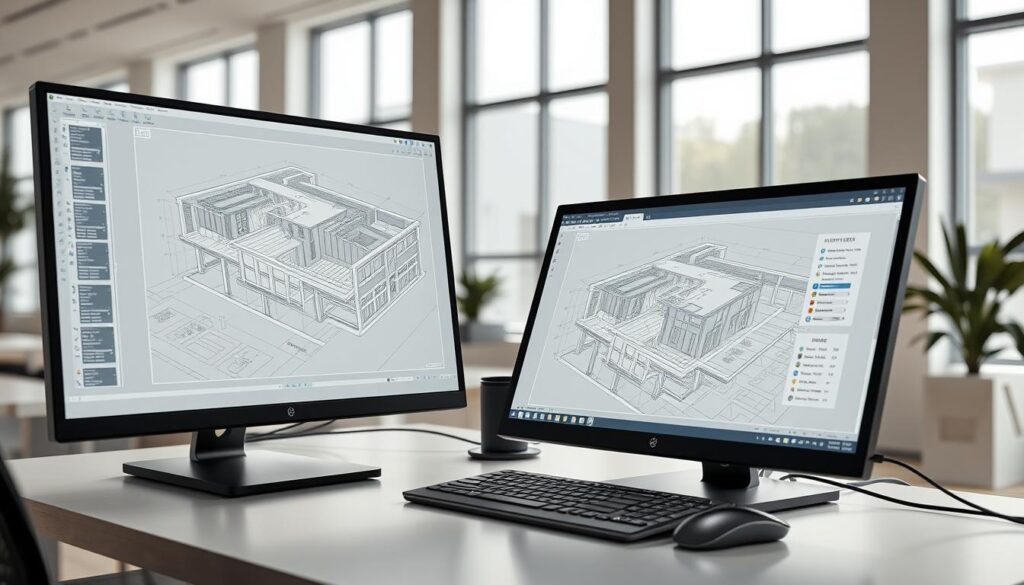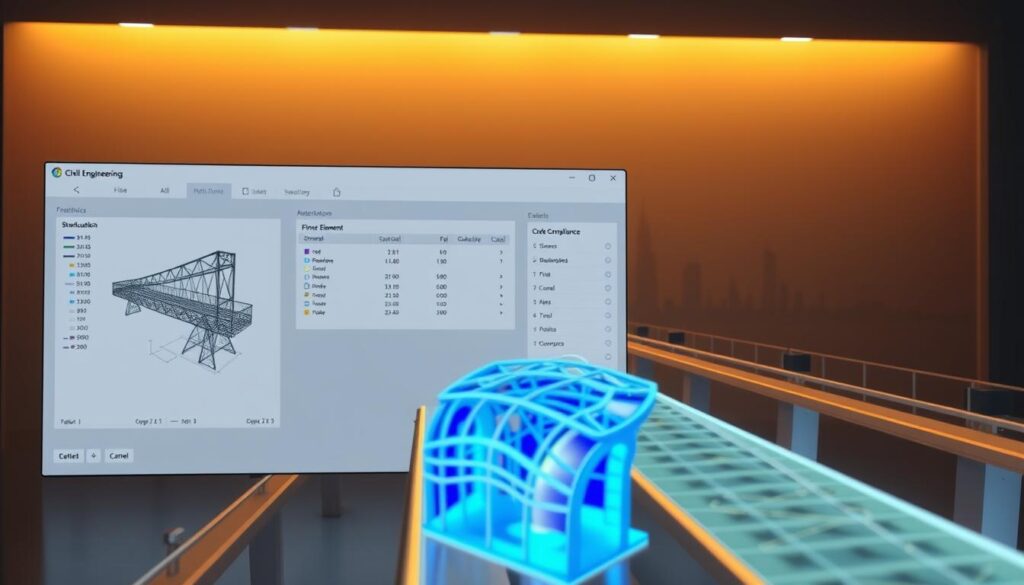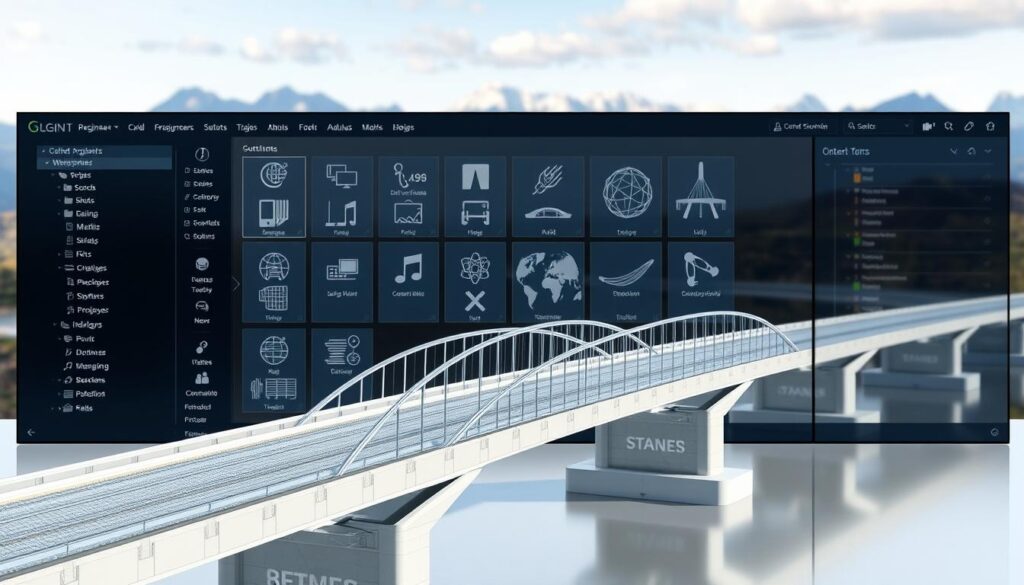The infrastructure development landscape is rapidly evolving, with infrastructure projects growing in complexity. Did you know that the global civil engineering market is projected to reach $8.1 trillion by 2025? This surge demands more efficient and precise design solutions.
Our cutting-edge CAD software for civil engineers is revolutionizing the way projects are designed and executed. By streamlining workflows, our software enables professionals to deliver superior results, meeting the increasing demands of the industry.
Key Takeaways
- Efficient design solutions are crucial for managing complex infrastructure projects.
- Our software streamlines workflows, enhancing productivity.
- Precise designs lead to superior project outcomes.
- The global civil engineering market is experiencing significant growth.
- Cutting-edge CAD software is essential for meeting industry demands.
What is Civil Engineering Design Software?
Civil engineering design software is a crucial tool for engineers to design, analyze, and optimize infrastructure projects. It encompasses a range of applications that aid in planning, designing, and managing construction projects efficiently.
Definition and Purpose
Civil engineering design software is designed to provide powerful tools for structural calculations and simulation capabilities. Its primary purpose is to assist engineers in creating accurate designs, analyzing data, and optimizing project outcomes. This software is used for various applications, including road design, bridge construction, and building layout.
For instance, AutoCAD Civil3D is a popular civil engineering analysis software that offers comprehensive tools for designing and analyzing infrastructure projects. It enables engineers to create detailed designs and simulate real-world conditions, thereby improving project efficiency and reducing costs.
Importance in Modern Engineering
The importance of civil engineering design software in modern engineering cannot be overstated. It has revolutionized the way infrastructure projects are planned, designed, and executed. By utilizing this software, engineers can enhance the accuracy of their designs, reduce project timelines, and minimize costs.
| Feature | Description | Benefit |
|---|---|---|
| Structural Design | Tools for designing and analyzing structural elements | Enhanced accuracy in designs |
| Simulation Capabilities | Ability to simulate real-world conditions | Improved project outcomes |
| Collaboration Tools | Features that facilitate team collaboration | Increased efficiency |
In conclusion, civil engineering design software, including structural design software, is an essential component of modern civil engineering. It provides the necessary tools for engineers to design, analyze, and optimize infrastructure projects, leading to improved project outcomes and reduced costs.
Key Features of Civil Engineering Design Software

Modern civil engineering design software is equipped with a range of features that enhance productivity and accuracy. These features are crucial for the successful completion of projects, from initial design to final implementation.
User-Friendly Interface
A user-friendly interface is essential for civil engineering design software, as it allows engineers to navigate and utilize the software’s capabilities efficiently. This interface simplifies complex tasks, reducing the learning curve and enabling users to focus on their designs rather than struggling with the software itself.
Advanced Modeling Tools
The advanced modeling tools available in civil engineering design software, such as civil engineering modeling software, enable the creation of detailed and accurate designs. These tools support the development of complex models, allowing for better analysis and simulation of real-world conditions. This capability is particularly valuable for projects that involve intricate designs or unique challenges.
Collaboration Capabilities
Collaboration capabilities are another key feature of modern civil engineering design software, including road design software. These capabilities facilitate teamwork by enabling multiple stakeholders to work together on a project simultaneously. This feature is crucial for large-scale projects that involve various teams and stakeholders, ensuring that all parties are aligned and working towards the same goals.
By incorporating these features, civil engineering design software significantly improves the design process, making it more efficient, accurate, and collaborative. As a result, engineers can deliver high-quality projects that meet the required standards and deadlines.
Types of Civil Engineering Design Software
The variety of civil engineering design software reflects the complexity and diversity of modern engineering projects. These software solutions are designed to cater to different aspects of civil engineering, from structural design to transportation engineering.
Structural Design Software
Structural design software is used for designing and analyzing buildings, bridges, and other infrastructure projects. It allows engineers to create detailed models, perform stress analysis, and simulate various loads. For instance, bridge design software is a specialized tool that helps in designing complex bridge structures. This type of software is crucial for ensuring the safety and durability of structures.
Some of the key features of structural design software include advanced modeling capabilities, dynamic analysis, and material optimization. These features enable engineers to create efficient and cost-effective designs.
Geotechnical Engineering Software
Geotechnical engineering software is used for analyzing soil, rock, and groundwater conditions. It helps engineers to design foundations, tunnels, and other underground structures. This software is essential for understanding the geotechnical aspects of a project and ensuring that the design is compatible with the site conditions.
Geotechnical engineering software often includes features such as soil modeling, slope stability analysis, and groundwater flow simulation. These features help engineers to predict and mitigate potential geotechnical hazards.
Transportation Engineering Software
Transportation engineering software is used for designing roads, highways, and other transportation infrastructure. It includes tools for alignment design, pavement design, and traffic analysis. For example, AutoCAD Civil 3D is a popular software used for road design and transportation engineering projects.
This type of software enables engineers to create efficient and safe transportation systems. It also helps in optimizing the design to reduce costs and environmental impact.
In conclusion, the different types of civil engineering design software are essential tools for modern engineers. By using these software solutions, engineers can improve the accuracy, efficiency, and sustainability of their projects.
Benefits of Using Civil Engineering Design Software

By leveraging civil engineering design software, professionals can significantly enhance their workflow and project outcomes. The numerous benefits of using such software include improved productivity, enhanced accuracy, and cost-effective solutions.
Increased Efficiency
Civil engineering design software streamlines the design process, allowing engineers to complete tasks more quickly and efficiently. This is achieved through features such as:
- Automated drafting tools
- Advanced modeling capabilities
- Collaboration tools that facilitate real-time communication among team members
As a result, projects can be completed on time, and engineers can take on more work without compromising quality. For more information on the importance of civil engineering software, visit this resource.
Enhanced Accuracy in Designs
CAD software for civil engineers enables the creation of precise designs, reducing the likelihood of errors that can lead to costly rework. The software’s advanced algorithms and modeling tools ensure that designs are accurate and comply with relevant standards and regulations.
The use of civil engineering drawing software also allows for the detection of potential issues early in the design phase, enabling engineers to make necessary adjustments before construction begins.
Cost-Effective Use
The adoption of civil engineering design software leads to significant cost savings. By reducing the time required to complete projects and minimizing errors, engineers can deliver projects within budget.
Additionally, the software’s ability to optimize designs and identify potential issues early on helps reduce waste and minimize the need for costly rework.
How to Choose the Right Software for Your Needs
The process of selecting the most suitable civil engineering design software involves evaluating your project needs, software features, and budget constraints. Choosing the right structural design software or civil engineering analysis software is crucial for the success of your projects.
Assessing Your Project Requirements
Before diving into the vast array of civil engineering design software options, it’s essential to assess your project requirements. This involves understanding the specific needs of your project, such as the type of design you need to create, the complexity of the project, and any specific features or functionalities required.
- Identify the type of project (e.g., road design, bridge construction)
- Determine the level of complexity
- Consider the necessary software features
Evaluating Software Features
Once you have a clear understanding of your project requirements, the next step is to evaluate the features of different civil engineering design software. Look for software that offers advanced modeling tools, user-friendly interfaces, and collaboration capabilities.
| Software Feature | Description | Importance Level |
|---|---|---|
| Advanced Modeling Tools | Allows for detailed and accurate design modeling | High |
| User-Friendly Interface | Enhances user experience and productivity | Medium |
| Collaboration Capabilities | Facilitates teamwork and communication among stakeholders | High |
Considering Budget and Cost
Budget is a critical factor when choosing civil engineering design software. It’s essential to consider not only the initial cost but also ongoing expenses such as maintenance, updates, and training.
By carefully assessing your project requirements, evaluating software features, and considering budget constraints, you can make an informed decision when selecting the right civil engineering design software for your needs.
Popular Civil Engineering Design Software Solutions

Popular civil engineering design software solutions are transforming the industry with their advanced features. These tools are designed to enhance the design, analysis, and management of infrastructure projects, making the process more efficient and accurate.
AutoCAD Civil 3D
AutoCAD Civil 3D is a powerful tool for civil engineers, offering a wide range of features for designing and analyzing infrastructure projects. It supports the creation of complex designs and provides tools for analyzing and optimizing designs. For more information on AutoCAD Civil 3D and other civil engineering software, visit https://www.cadd.net.in/civil-engineering-software/.
Bentley OpenRoads
Bentley OpenRoads is another leading software solution that provides comprehensive tools for road design, analysis, and construction. It enables engineers to work more efficiently and deliver high-quality projects. The software is particularly useful for road design software needs, offering advanced modeling capabilities.
Revit for Civil Engineering
Revit is widely used in the building industry, but it also offers capabilities for civil engineering projects. It provides a robust platform for building information modeling (BIM), which can be beneficial for civil engineering modeling software applications.
The following table compares the key features of these popular software solutions:
| Software | Key Features | Applications |
|---|---|---|
| AutoCAD Civil 3D | Advanced design and analysis tools, support for complex designs | Infrastructure projects, transportation engineering |
| Bentley OpenRoads | Comprehensive road design and analysis tools, construction management | Road design, transportation projects |
| Revit for Civil Engineering | BIM capabilities, robust modeling features | Civil engineering projects, building information modeling |
These software solutions have become essential tools in the civil engineering industry, enhancing productivity and improving project outcomes. By leveraging the right software, engineers can streamline their workflows and achieve better results.
Integrating Software into Your Workflow
A well-planned integration of software is key to unlocking its full potential in civil engineering projects. To achieve this, it’s crucial to follow best practices that ensure a seamless transition to the new software.
Best Practices for Implementation
Implementing civil engineering design software requires careful planning. Start by assessing your project requirements and evaluating the software features that meet those needs. It’s also essential to consider the compatibility of the software with your existing systems and tools.
- Define your project goals and identify the software features that support them.
- Assess the compatibility of the software with your existing infrastructure.
- Develop a comprehensive implementation plan, including timelines and milestones.
For more insights on seamless integration, you can refer to this article on integrating software into your.
Training Your Team
Training is a critical component of successful software integration. Ensure that your team is well-versed in using the software by providing comprehensive training programs. This can include workshops, online tutorials, and hands-on practice sessions.
“The key to successful software implementation is not just about the technology itself, but also about how well your team can use it.”
Effective training will help your team to efficiently use the software, thereby enhancing productivity and reducing errors.
Continuous Improvement and Updates
Civil engineering design software is continually evolving, with new features and updates being released regularly. To maximize the benefits of the software, it’s essential to stay updated with the latest developments.
- Regularly review and update your software to ensure you have the latest features.
- Encourage feedback from your team on the software’s performance and suggest improvements.
- Participate in user forums and communities to stay informed about best practices and new trends.
By following these best practices, you can ensure that your civil engineering design software is fully integrated into your workflow, enhancing your design capabilities and improving overall efficiency.
Future Trends in Civil Engineering Design Software

As we look to the future, it’s clear that civil engineering design software will be shaped by several key trends. The industry is on the brink of a technological revolution, with advancements that promise to enhance efficiency, accuracy, and sustainability in infrastructure design and project management.
AI and Machine Learning Applications
One of the most significant trends is the integration of Artificial Intelligence (AI) and Machine Learning (ML) into civil engineering design software. These technologies are poised to automate repetitive tasks, improve design accuracy, and enable more complex analyses. For instance, AI can help in optimizing designs based on various parameters such as cost, material usage, and environmental impact.
Cloud-Based Solutions
Cloud computing is another trend that is transforming the civil engineering design software landscape. Cloud-based solutions offer greater flexibility, scalability, and collaboration capabilities. Teams can work together in real-time from different locations, and projects can be accessed from anywhere, at any time. This trend is expected to continue, with more software solutions moving to the cloud.
Sustainability Focus
Sustainability is becoming increasingly important in civil engineering, and design software is reflecting this trend. Future software solutions are likely to include more features that support sustainable design practices, such as energy efficiency analysis, material sustainability assessments, and environmental impact evaluations. This focus on sustainability will help engineers design infrastructure that is not only functional and cost-effective but also environmentally friendly.
In conclusion, the future of civil engineering design software is exciting and rapidly evolving. With advancements in AI and ML, cloud-based solutions, and a focus on sustainability, the industry is set to make significant strides in the coming years. These trends will not only improve the design process but also contribute to more sustainable and resilient infrastructure.
How to Improve Your Skills with the Software
Staying updated with the latest features in civil engineering analysis software is vital for delivering high-quality designs. As the industry evolves, so does the technology that supports it, making continuous learning a necessity for professionals.
Online Tutorials and Resources
One of the most effective ways to improve your skills is by leveraging online tutorials and resources. Many software providers offer comprehensive guides, video tutorials, and webinars that cover both basic and advanced features. For instance, platforms like YouTube and Udemy have extensive courses on using CAD software for civil engineers.
Certification Programs
Participating in certification programs is another excellent way to enhance your proficiency. These programs not only validate your skills but also demonstrate your commitment to potential employers or clients. Certifications from recognized software providers can significantly boost your career prospects.
Joining Professional Communities
Joining professional communities and forums can provide valuable insights and support. These communities often share best practices, discuss new features, and offer troubleshooting tips. Engaging with other professionals can help you stay informed about the latest trends and advancements in civil engineering design software.
By combining these strategies, you can significantly improve your skills and stay competitive in the field. Whether you’re just starting out or looking to advance your career, continuous learning and professional development are key.
Case Studies: Success Stories Using Software

The use of civil engineering modeling software has revolutionized the way major infrastructure projects are designed and executed. By leveraging advanced software solutions, engineers can now create more accurate and detailed designs, collaborate more effectively, and deliver projects on time and within budget.
Major Infrastructure Projects
Several major infrastructure projects have successfully utilized civil engineering design software to achieve remarkable results. For instance, the construction of the new Denver International involved the use of advanced structural design software to design and analyze complex structural systems.
Another example is the renovation of the Los Angeles Metro Rail system, which employed civil engineering modeling software to optimize the design and construction process. The software enabled engineers to simulate different scenarios, identify potential issues, and develop effective solutions.
Innovative Design Solutions
The use of civil engineering design software has enabled engineers to develop innovative design solutions that were previously impossible to achieve. For example, the software has been used to create complex 3D models, simulate various environmental conditions, and optimize structural performance.
One notable example is the use of structural design software to design the iconic Gateway Arch in St. Louis, Missouri. The software enabled engineers to create a highly accurate and detailed model of the arch, taking into account various loads and stresses.
Lessons Learned
The case studies of successful infrastructure projects that have utilized civil engineering design software provide valuable insights and lessons learned. Some of the key takeaways include the importance of:
- Collaboration and communication among project stakeholders
- Accurate and detailed design and analysis
- Simulation and testing of different scenarios
- Continuous monitoring and updating of project data
| Project | Software Used | Benefits |
|---|---|---|
| Denver International Airport | Structural Design Software | Improved accuracy, reduced construction time |
| Los Angeles Metro Rail | Civil Engineering Modeling Software | Optimized design, reduced costs |
| Gateway Arch | Structural Design Software | Highly accurate and detailed design |
Addressing Common Challenges in Civil Engineering Software
Despite the benefits of civil engineering software, several common challenges can hinder its effective use. These challenges can range from technical issues to user-related barriers.
Compatibility Issues
One of the significant challenges faced by civil engineers is ensuring that the software they use is compatible with existing systems and other tools. For instance, bridge design software must be able to integrate seamlessly with other software used in the project lifecycle. Compatibility issues can lead to data loss, project delays, and increased costs. To mitigate this, it’s essential to choose software that supports open standards and has a proven track record of interoperability.
Software Limitations
Another challenge is understanding the limitations of the software. While civil engineering design software has become increasingly sophisticated, it is not without its limitations. For example, certain road design software might not handle complex terrain modeling as effectively as others. Being aware of these limitations allows engineers to work within the software’s capabilities and seek alternative solutions when necessary. Regular updates and feedback to software vendors can also help in addressing these limitations over time.
User Adoption Barriers
User adoption is a critical factor in the successful implementation of civil engineering software. Barriers to adoption can include a lack of training, resistance to change, and complexity of the software interface. To overcome these barriers, it’s crucial to provide comprehensive training and support to users. Additionally, selecting software with an intuitive and user-friendly interface can significantly reduce the learning curve and enhance user adoption. For more insights on effective project management in civil engineering, visit civil engineering project management resources.
The Role of Software in Environmental Sustainability

The use of civil engineering design software is crucial for reducing the environmental footprint of infrastructure projects. By leveraging advanced software, engineers can create more sustainable designs, minimize waste, and ensure compliance with environmental regulations.
Civil engineering design software offers various eco-friendly design features that help engineers design more sustainable infrastructure projects. For instance, it allows for the simulation of different environmental scenarios, enabling engineers to choose the most sustainable option. To learn more about the essential software for civil engineers, visit https://worldcivilsociety.com/essential-software-for-civil-engineers/.
Eco-Friendly Design Features
Modern civil engineering design software includes features that support eco-friendly design. These features enable engineers to analyze the environmental impact of their designs and make necessary adjustments. For example, software can simulate the effect of a project on local ecosystems, helping engineers to minimize harm.
Compliance with Regulations
Civil engineering design software also aids in ensuring compliance with environmental regulations. The software can be updated with the latest regulatory requirements, ensuring that designs meet or exceed these standards. This not only helps in avoiding legal issues but also in promoting sustainable practices.
Minimizing Waste
Another significant benefit of using civil engineering design software is the ability to minimize waste. By optimizing designs, engineers can reduce the amount of materials needed for a project, thereby minimizing waste and reducing the project’s environmental footprint.
In conclusion, civil engineering design software and architectural design software play a vital role in promoting environmental sustainability. By utilizing these tools, engineers can create more sustainable designs, ensure compliance with regulations, and minimize waste, ultimately contributing to a more environmentally friendly infrastructure development process.
Enhancing Collaboration Through Software
Effective collaboration is the backbone of successful civil engineering projects, and civil engineering drawing software is revolutionizing the way teams work together. By utilizing the right tools, teams can streamline project management, facilitate stakeholder communication, and enable real-time updates.
Civil engineering design software has become an indispensable tool in modern engineering projects. It not only enhances the design process but also fosters collaboration among team members and stakeholders. With features like project management tools, stakeholder communication strategies, and real-time update capabilities, this software is transforming the way civil engineering projects are executed.
Project Management Tools
Project management is a critical aspect of civil engineering projects. Civil engineering drawing software provides robust project management tools that enable teams to plan, track, and execute projects more efficiently. These tools include:
- Gantt charts for scheduling and timeline management
- Task assignment and tracking features
- Resource allocation and management capabilities
By utilizing these tools, teams can ensure that projects are completed on time and within budget.
Stakeholder Communication
Effective stakeholder communication is crucial for the success of civil engineering projects. CAD software for civil engineers facilitates communication among stakeholders by providing a platform for sharing information and collaborating on designs. This includes:
| Feature | Description | Benefit |
|---|---|---|
| Real-time commenting | Allows stakeholders to comment on designs in real-time | Improves communication and reduces misunderstandings |
| Design sharing | Enables stakeholders to access and review designs | Facilitates collaboration and feedback |
As
“The key to successful project delivery is effective collaboration and communication among stakeholders.”
This quote highlights the importance of stakeholder communication in civil engineering projects.
Real-Time Updates
One of the key benefits of using civil engineering design software is the ability to make real-time updates. This feature ensures that all stakeholders have access to the latest design information, reducing errors and miscommunication.
By leveraging real-time updates, teams can respond quickly to changes and challenges, ensuring that projects stay on track.
Ensuring Compliance and Standards with Software

Civil engineering design software plays a vital role in adhering to local regulations and industry standards. This software is designed to help engineers and designers create projects that meet the necessary compliance requirements, reducing the risk of errors and non-compliance.
Understanding Local Regulations
Local regulations vary significantly across different regions, making it crucial for civil engineers to understand and comply with these regulations. Structural design software and civil engineering analysis software are equipped with features that help users stay updated with local building codes and regulations.
For instance, using structural design software, engineers can ensure that their designs meet local building codes and regulations. This not only helps in avoiding legal issues but also ensures the safety and integrity of the structure.
Keeping Up with Industry Standards
Industry standards are continually evolving, and it is essential for civil engineers to keep up with these changes. The latest CAD standards and best can be integrated into civil engineering design software, ensuring that projects are designed according to the latest industry requirements.
| Industry Standard | Description | Software Feature |
|---|---|---|
| Building Codes | Regulations governing building design and construction | Automated code checking |
| Environmental Regulations | Standards for minimizing environmental impact | Environmental impact analysis |
| Safety Standards | Guidelines for ensuring structural safety | Structural analysis and simulation |
By utilizing civil engineering analysis software, engineers can analyze their designs for compliance with industry standards, making adjustments as necessary to ensure that their projects meet all relevant requirements.
Customer Support and Resources
Effective customer support and resources are crucial for maximizing the benefits of civil engineering design software, such as civil engineering modeling software and bridge design software. Users can rely on various resources to address questions and challenges, ensuring seamless project execution.
Technical Support Access
Users can access technical support through multiple channels, including phone, email, and online chat. This support is vital for resolving issues promptly and minimizing project delays.
User Guides and Documentation
Comprehensive user guides and documentation are available to help users understand the software’s capabilities and features. These resources enable users to optimize their use of civil engineering design software.
Engaging with Online Communities
Online forums and communities provide a platform for users to share experiences, ask questions, and learn from others. Engaging with these communities can enhance users’ proficiency with civil engineering modeling software and bridge design software.
By leveraging these customer support and resources, users can optimize their use of civil engineering design software, leading to more efficient and accurate project outcomes.
